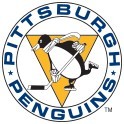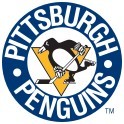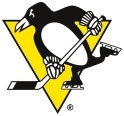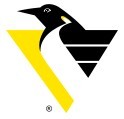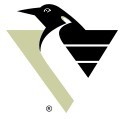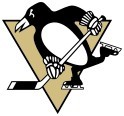
| Pittsburgh Penguins | |
| 2012–13 Pittsburgh Penguins season | |
 |
|
| Conference | Eastern |
| Division | Atlantic |
| Founded | 1967 |
| History |
Pittsburgh Penguins 1967–present |
| Home arena | Consol Energy Center |
| City | Pittsburgh, Pennsylvania |
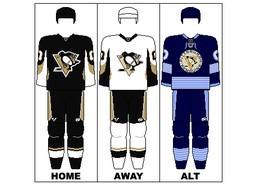 |
|
| Colors |
Black, Vegas Gold, White |
| Media |
Root Sports Pittsburgh The X (105.9 FM) ESPN Pittsburgh (970 AM) Pittsburgh Post-Gazette Pittsburgh Tribune-Review |
| Owner(s) |
Mario Lemieux Ronald Burkle |
| General manager | Ray Shero |
| Head coach | Dan Bylsma |
| Captain | Sidney Crosby |
| Minor league affiliates |
Wilkes-Barre/Scranton Penguins(AHL) Wheeling Nailers (ECHL) |
| Stanley Cups | 3 (1990–91, 1991–92, 2008–09) |
| Conference championships | 4 (1990–91, 1991–92, 2007–08, 2008–09 |
| Presidents' Trophies | 1 (1992–93) |
| Division championships | 7 (1990–91, 1992–93, 1993–94, 1995–96, 1997–98, 2007–08, 2012–13) |
| Official website | penguins.nhl.com |
The Pittsburgh Penguins are a professional ice hockey team based in Pittsburgh, Pennsylvania. They are members of the Atlantic Division of the Eastern Conference of the National Hockey League(NHL). The franchise was founded in 1967 as one of the first expansion teams during the league's original expansion from six to twelve teams. The Penguins played in the Civic Arena, also known to Pittsburgh fans as "The Igloo", from the time of their inception through the end of the 2009–10 season. They moved into their new arena, Consol Energy Center, to begin the 2010–11 NHL season. They have qualified for four Stanley Cup Finals, winning the Stanley Cup three times in their history – in 1991, 1992, and 2009.
Franchise history
Beginnings (1965 to 1969)
Before the Penguins, Pittsburgh had been the home of the NHL's Pirates from 1925 to 1930 and of the Hornets AHL franchise from 1936 to 1967 (with a short break from 1956 to 1961). In the spring of 1965, Jack McGregor, a state senator from Kittanning, began lobbying campaign contributors and community leaders to bring an NHL franchise back to Pittsburgh. The group focused on leveraging the NHL as an urban renewal tool for Pittsburgh. The senator formed a group of local investors that included H. J. Heinz Company heir H. J. Heinz III, Pittsburgh Steelers owner Art Rooney, and theMellon family's Richard Mellon Scaife. The 1967 NHL Expansion depended on securing votes from the then-current NHL owners; to ensure that Pittsburgh would be selected for expansion, McGregor enlisted Rooney to petition votes from James D. Norris, owner of the Chicago Blackhawks, and his brother Bruce Norris, owner of the Detroit Red Wings.
The effort was successful, and on February 8, 1966, the National Hockey League awarded an expansion team to Pittsburgh for the 1967–68 season. The Penguins paid $2.5 million ($17.2 million today) for their entry and $750,000 ($5.2 million today) more for start-up costs. The Civic Arena's capacity was then boosted from 10,732 to 12,500 to meet the NHL requirements for expansion. The Pens also paid an indemnification bill to settle with the Detroit Red Wings, who held the rights to the Pittsburgh Hornets. The investor group named McGregor president and chief executive officer, and he represented Pittsburgh on the NHL's Board of Governors.
After deciding on the "Penguin" nickname (which was inspired by the fact that the team was to play in the "Igloo", the nickname of the Pittsburgh Civic Arena),[2] a logo was chosen that had a penguin in front of a triangle, which symbolized the "Golden Triangle" of downtown Pittsburgh."
The Penguins' first general manager, Jack Riley opened the first preseason camp for the franchise in Brantford, Ontario[4] on September 13, 1967, playing the franchise's first exhibition match in Brantford against the Philadelphia Flyers on September 23, 1967. The Pens, along with the rest of the expansion teams were hampered by restrictive rules that kept most major talent with the "Original Six". Beyond aging sniper Andy Bathgate and tough defenseman Leo Boivin, the first Penguins team was manned by a cast of former minor leaguers. On October 11, 1967, league president Clarence Campbell and McGregor jointly dropped the ceremonial first puck of the Penguins opening home game against the Montreal Canadiens.[1]On October 21, 1967, they became the first team from the expansion class to beat an Original Six team, as they defeated the Chicago Black Hawks 4–2. However, the Penguins went 27–34–13, missing the playoffs and ending with the third worst record in the league. Though Bathgate led the team in scoring, both he and Boivin were soon gone. George Sullivan was the head coach for the club's first two seasons until he was replaced by Hockey Hall of Famer Red Kelly. The next season, 1968-69 the Penguins changed their uniforms to the black circle logo with the skating penguin. Jean Pronovost made his debut with the team. They ended up being last place in the league.
Triumph of Playoff berths and Tragedy of Briere (1970–1974)
With the exception of a handful of decent players such as Ken Schinkel, Jean Pronovost, Syl Apps Jr., Keith McCreary, agitator Bryan Watson and goaltender Les Binkley, talent was otherwise thin, but enough for the Penguins to reach the playoffs in both 1970 and 1972.
In the 1969 draft the Penguins selected Michel Briere who although being chosen 26th soon was drawing comparisons to Phil Esposito and Bobby Clarke. Joining the team in November, he finished as the top rookie scorer in the NHL with 44 points (57th overall), and third on the Penguins. Briere placed second in Calder Memorial Trophy voting for Rookie of the Year honors to Chicago goalie Tony Esposito in leading Pittsburgh to its first NHL playoff berth since the 1928 Pirates. The Penguins defeated the Oakland Seals in a four game sweep in the quarter-finals, with Briere scoring the series-clinching goal in overtime. In the semi-final round, defending conference champions St. Louis Blues got the best of the Penguins during six games. Briere led the team in playoff scoring, recording five goals (including three game winners) and eight points.
Tragedy struck the Penguins just days after their playoff heroics. On May 15, 1970, Briere was in a car crash in his native Quebec, suffering brain trauma and going into a coma from which he would never recover, dying a year later. His #21 jersey was never reissued, remaining out of circulation for the Penguins until it was formally retired in 2001.
The next season the Penguins finished five games out of the playoffs with a 21–37–20 record, the fourth worst record in the league. Pittsburgh achieved a playoff berth in 1972 only to be swept by the Chicago Black Hawks in the first round.
The Penguins battled the California Golden Seals for the division cellar in 1974, when Riley was fired as general manager and replaced with Jack Button. Button traded for Steve Durbano, Ab DeMarco, Bob "Battleship" Kelly and Bob Paradise. The personnel moves proved successful, as the team improved to a 28–41–9 record, although they remained nine points away from a playoff berth.
In early 1975, however, the Penguins' creditors demanded payment of back debts, forcing the team into bankruptcy. The doors to the team's offices were padlocked, and it looked like the Penguins might fold or relocate.[citation needed] Around the same time, rumors had begun to circulate that the Penguins and California Golden Seals were to be relocated to Seattle and Denver respectively, the two cities that were to have been the sites of an expansion for the 1976–77 season.[5]Through the intervention of a group that included former Minnesota North Stars head coach Wren Blair, the team was prevented from folding and remained in Pittsburgh.
Playoff Runs and a Uniform Change (1975–1982)
Beginning in the mid-seventies, Pittsburgh iced some powerful offensive clubs, led by the likes of the "Century Line" of Syl Apps, Lowell MacDonald and Jean Pronovost. They nearly reached the Stanley Cup semifinals in 1975, but were ousted from the playoffs by the New York Islanders in one of the only three best-of-seven game series in NHL history where a team came back from being down three games to none. As the 1970s wore on, the Penguins brought in other offensive weapons such as Rick Kehoe, Pierre Larouche and Ron Schock, along with solid blue-liners Ron Stackhouse and Dave Burrows. But the Pens' success beyond the regular season was always neutralized by mediocre team defense. Goaltender Denis Herron was a stalwart in goal for parts of six seasons.
Aldege "Baz" Bastien, a former coach and general manager of the AHL Hornets, later became general manager. The Penguins missed the playoffs in 1977–78 when their offense lagged, and Larouche was traded for Peter Mahovlich and Peter Lee. Bastien traded prime draft choices for several players whose best years were already behind them, such as Orest Kindrachuk, Tom Bladon and Rick MacLeish, and the team would suffer in the early 1980s as a result. The decade closed with a playoff appearance in 1979 and a rousing opening series win over the Buffalo Sabres before a second-round sweep at the hands of the Boston Bruins.
The Penguins began the 1980s by changing their team colors. In January 1980, the team switched from wearing blue and white to their present-day scheme of black and gold to honor Pittsburgh's other sports teams, the Pirates and theSteelers, as well as the Flag of Pittsburgh. Both the Pirates and Steelers had worn black and gold for decades, and both were fresh off world championship seasons at that time. The Bruins protested this color change, claiming a monopoly on black and gold, but the Penguins defended their choice by stating that the NHL Pirates also used black and gold as their team colors, and that that black and gold were Pittsburgh's traditional sporting colors. The NHL agreed, and Pittsburgh was allowed to use black and gold. The Penguins officially debuted wearing black and gold against the St. Louis Blues at the Civic Arena on January 30th, 1980.
On the ice, the Penguins began the 1980s with defenseman Randy Carlyle, and prolific scorers Paul Gardner and Mike Bullard, but little else.
During the early part of the decade, the Penguins made a habit of being a tough draw for higher-seeded opponents in the playoffs. In 1980, the 13th seeded Penguins took the Bruins to the limit in their first round playoff series. The following season, as the 15th seed, they lost the decisive game of their first-round series in overtime to the heavily favored St. Louis Blues. Then, in the 1982 playoffs, the Penguins held a 3–1 lead late in the fifth and final game of their playoff series against the reigning champions, the New York Islanders. However, the Islanders rallied to force overtime and won the series on a goal by John Tonelli. It would be the Pens' final playoff appearance until 1989.
Decline and the arrival of Mario Lemieux (1983–1988)
The team had the league's worst record in both the 1983 and 1984 seasons, and with the team suffering financial problems, it again looked as though the Penguins would fold. Mario Lemieux, one of the most highly touted NHL draft picks in history, was due to be drafted in the 1984 NHL Entry Draft. Heading towards the end of the season ahead of the New Jersey Devils, who were placed last, the Penguins made a number of questionable moves that appeared to weaken the team in the short-term. The Penguins posted three six-game winless streaks in the last 21 games of the season and earned the right to draft Lemieux amidst protests from Devils management.[7] Pittsburgh coach Lou Angotti later admitted that a conscious decision was made to finish the season as the team with the worst record, stating in an interview with the Pittsburgh Post-Gazette that a mid-season lunch prompted the plan, in light of the fact that there was a high chance of the franchise folding if Lemieux was not drafted.[8] In particular, Angotti gave the example of a game the Penguins were winning 3–1, at which point general manager Eddie Johnston asked the coach "what are you doing?" in the first intermission of the game that was eventually lost 6–3. The Penguins were still, despite losing ten of their last twelve games, only two games away from losing Lemieux to the Devils.[8] However, Angotti stated that he did not feel comfortable with the plan, even though it worked and saved the franchise. Other teams offered substantial trade packages for the draft choice, but the Penguins kept the pick and drafted Lemieux first overall.
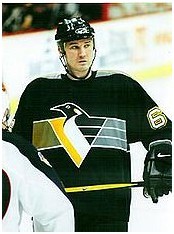
Lemieux paid dividends right away, scoring on the first shot of his first shift in his first NHL game. However, the team spent four more years out of the playoffs after his arrival. In the late 1980s, the Penguins finally gave Lemieux a strong supporting cast, trading for superstar defenseman Paul Coffey from the Edmonton Oilers (after the Oilers' 1987 Stanley Cup win) and bringing in young talent such as scorersKevin Stevens, Rob Brown and John Cullen from the minors. Also, the team at last acquired a top-flight goaltender with the acquisition of Tom Barrasso from Buffalo.
All this talent had an immediate impact in helping Lemieux lead the Pens; but the Penguins struggled to make the playoffs. The 1985–86 Pens unluckily missed the playoffs on the final day of the season by one game. In 1986–87 the Penguins missed the playoffs by just two games and saw four teams with equal or worse records qualify. In 1987–88 the team again missed the playoffs on the last day of the season by one game.
The Era of Mario Lemieux (1989–1997)
In 1989, Pittsburgh finally broke through the barrier and made the playoffs, on the back of Lemieux leading the league in goals, assists and points. On December 31, 1988, Lemieux became the only player in history to score a goal in all five possible game situations in the same game (even strength, shorthanded, penalty shot, power play, and empty net). The Pens shocked the New York Rangers in a four game sweep in the first round, however their run was halted by the Philadelphia Flyers in the second round. The seven game defeat featured Mario Lemieux scoring five goals in the fifth game.
A herniated disc in Lemieux's back cut short his 1989–90 NHL season, although he still amassed 123 points. However this was not enough and the Pens slipped out of the playoff picture. The Penguins opted to strengthen their roster and support Lemieux in the 1990 offseason. Free agent signings (Bryan Trottier) and talents acquired via trade (Joe Mullen, Larry Murphy, Ron Francis and Ulf Samuelsson) played a major part of this. The signings culminated in the Penguins winning their first Stanley Cup by defeating the Minnesota North Stars in the Stanley Cup finals in six games, punctuated by a 8–0 victory in the deciding game, the largest margin of victory in a final Cup game in over 80 years. After the 1991 Stanley Cup Finals, the Penguins met with President George H. W. Bush, the first NHL team to ever visit the White House.[9] The following season, the team lost coach Bob Johnson to cancer, and Scotty Bowman took over as coach. Under Bowman, they swept the Chicago Blackhawks to repeat as Stanley Cup champions in 1991–92.
Cancer revisited the Penguins in 1993, when Lemieux was diagnosed with Hodgkin's disease. Only two months after the diagnosis, missing 24 out of 84 games, he came back to win his fourth Art Ross Trophy as scoring champion with 160 points, edging out Pat LaFontaine and Adam Oates. Despite the off-ice difficulties, Pittsburgh finished with a 56–21–7 record – the franchise's best regular season ever – winning the franchise's first (and, as of 2012, only) Presidents' Trophy. After Lemieux's return, the team played better than it ever had before, winning an NHL-record 17 consecutive games. Despite all of this success, they were eliminated in the second round by the New York Islanders in overtime of Game 7.

The Penguins continued to be a formidable team throughout the 1990s. The stars of the Stanley Cup years were followed by the likes of forwards Alexei Kovalev, Martin Straka, Aleksey Morozov, Robert Langand Petr Nedved, and defensemen Sergei Zubov, Darius Kasparaitis and Kevin Hatcher. The Pens would use this talent to reach the first round of the playoffs in 1994, the second round in 1995, seven game into the conference finals in 1996, until the success was halted a five-game first round exit to the Philadelphia Flyers in 1997.
Mario Lemieux Retires and Returns, Second Bankruptcy (1998–2001)
Mario Lemieux also then announced retirement due to health-related issues. Lemieux was so respected in the league, and his achievements over the course of his career were so great, that he was inducted into the Hockey Hall of Fame in the same year as he retired, the three-year waiting period being waived. However, it left the Penguins struggling to fill in the void he had left, with a first round exit in 1998 despite being the second seeded team in the East followed by a second round exit in 1999 this time from eighth seed. In 2000 the Penguins stunned the highly touted Washington Capitals 4–1 in the first round only to fall to the Philadelphia Flyers 4–2 in the second round.
The Penguins were simultaneously in the midst of a battle for their survival. Their free-spending ways in the early 1990s came with a price; at one point they owed over $90 million to various creditors. Owners Howard Baldwin and Morris Belzberg (who bought the Penguins after their first Cup win) asked the players to defer their salaries to help pay the bills. When the deferred salaries finally came due, combined with other financial pressures, the Penguins were forced to file for Chapter 11 bankruptcy in November 1998. For much of the 1998–99 season, it looked like the Penguins would either move or fold.
At this point, Lemieux stepped in with an unusual proposal. Years of deferred salary adding up to $30 million made him one of the team's largest creditors. He proposed to recover this money by converting it into equity and buying the team, and promised to keep it in Pittsburgh. The league and the court agreed, and Lemieux, with help from supermarket tycoon Ronald Burkle, assumed control on September 3, 1999 — thus saving the franchise for the second time.
Lemieux shocked the hockey world by deciding to come back as a player on December 27, 2000, having gained a stake in ownership of the franchise in 1999, becoming the first player–owner in NHL history. Lemieux helped lead the Penguins deep into the 2001 playoffs, highlighted by an overtime victory against the Buffalo Sabres in Game 7 of the second round. Kasparaitis scored the series-clinching goal to advance the Penguins to the Eastern Conference Finals, where they lost in five games to the New Jersey Devils.
Losing Seasons, Rebuilding and Mario Lemieux Retires again (2002–2006)
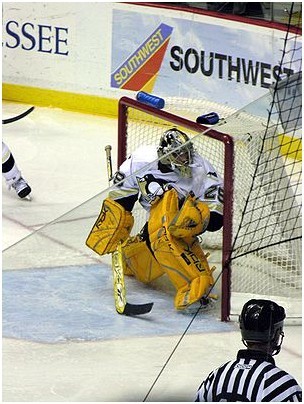
The Penguins attendance had dwindled in the late 90s. In 1998–99, the Penguins had an average attendance 14,825 tickets at home games, the lowest it had been since Lemieux's rookie year.[10]Reducing revenue on top of the previous bankruptcy necessitated salary shedding. The biggest salary move was the trading of superstar Jaromir Jagr to the Washington Capitals in the summer of 2001. The return for Jagr was mediocre, at best, as it returned prospects Kris Beech, Michal Sivek, and Ross Lupaschuk. The Penguins missed the playoffs for the first time in 12 years in 2002, finishing in a tie for third-to-last in the conference. Further financial difficulties saw them trade Alexei Kovalev to the New York Rangers the next season, quickly followed by the departure of Lang in free agency. The 2002–03 season was little better, with the team finishing second-last in the conference. The situation began to echo the dark days of the early 1980s. However, just like in the 1980s, the Penguins used the opportunity to rebuild through the draft and acquire elite prospects. In the 2003 NHL Entry Draft, the Penguins picked with their first-overall selection goaltender Marc-Andre Fleury.
The 2003–04 season was a difficult ordeal, with Lemieux suffering a season-ending hip injury early in the season, and attendance dipping to an average of 11,877 (the lowest average out of any NHL team) and only one game sold out.[10] As the season went on, the Penguins signed new head coach (and former Penguin and commentator) Eddie Olczyk, traded Martin Straka to the Los Angeles Kings, and opted not to include the highly rated Fleury in the lineup for the bulk of the 03–04 season. This culminated in the worst record in the NHL, winning just 23 games, putting the Penguins in line to draft 'can't-miss' Russian phenom Alexander Ovechkin with the number one pick. However, the Penguins were unable to secure the first overall draft pick as they lost the draft lottery for the 2004 NHL Entry Draft to the Washington Capitals. Ovechkin went to Washington, but the Penguins did select Evgeni Malkin with the second overall pick. Several years later, Malkin would be hailed as the best pick of that draft; a pick that would help to propel the Penguins back to a competitive level in future years.
The Penguins had collapsed financially since the cup winning years of the early 90s. The situation was so dire that there was a suggestion that the franchise be moved to Kansas City, Missouri.[11] The 2004-05 NHL season was canceled due to the NHL lockout. One of the many reasons for the lockout included disagreements on the resolution of the financial struggles of teams like the Penguins and Ottawa Senators, who had filed for bankruptcy protection.[12] In the midst of the lockout, the Penguins dispersed between the club's American Hockey League affiliateWilkes-Barre/Scranton Penguins and European leagues. Morozov and Milan Kraft would elect to not return to the Penguins after the lockout, and instead remain in the European leagues.
With the lockout resolved in 2005, the league organized an unprecedented draft lottery to set the 2005 draft order. The draft lottery, which was held behind closed doors in a "secure location", ended with the Penguins holding the first overall pick for the second time in three years.[13] The Penguins chose highly touted junior league player Sidney Crosby from the Rimouski Océanic of the Quebec Major Junior Hockey League, who had been training with Lemieux over the summer.
The Penguins then began rebuilding the team under a salary cap. They signed free agents Sergei Gonchar, John LeClair, and Zigmund Palffy, and traded for goaltender Jocelyn Thibault. However,Evgeni Malkin, the Penguins' 2004 NHL Entry Draft selection with their 2nd overall pick, could not come to Pittsburgh immediately due to a dispute with his Russian league.
The addition of Crosby paid dividends in attendance and revenue – with attendance rising by approximately 4,000 on average in the 2005–2006[10] – but was not as effective in translating to wins, as the team began the season with a long winless skid that resulted in a coaching change from Olczyk to Michel Therrien. Palffy announced his retirement due to a lingering shoulder injury while the team's second-leading scorer. Then on January 24, 2006, Lemieux announced his second retirement, this time for good, after developing an irregular heart beat. He finished as the NHL's seventh all-time scorer (1,723), eighth in goals (690) and tenth in assists (1,033), but also with the second highest career points per game average (1.88), which is second to Wayne Gretzky's 1.92.
As the poor season continued, Crosby had a highly productive rookie season. On the Penguins' final game of the season, Crosby scored a goal and an assist to become the top scoring rookie in Penguins history with 102 points (eclipsing Lemieux), despite losing the rookie scoring race to Russian superstar Ovechkin, who, unlike Malkin, was also set to debut that season, been able to make his way to the NHL. The Penguins once again posted the worst record of the Eastern Conference and the highest goals-against in the league. They received the second overall draft pick after losing the lottery, their fourth top 2 pick in four years, in the 2006 NHL Draft and picked highly touted two-way forward Jordan Staal.
The team announced on April 20 that the contract for General Manager Craig Patrick would not be renewed. Patrick had been GM since December 1989. On May 25, Ray Shero signed a five-year contract as General Manager.
The Crosby-Malkin Era (2006–present)
2006–07 season: The entry of Malkin and an arena deal
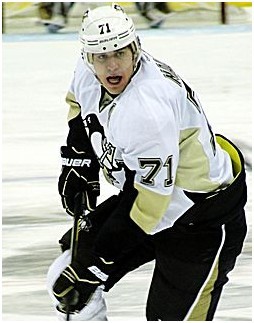
Jordan Staal, drafted 2nd overall in 2006, scored 29 goals in his first NHL season
Change came for the Penguins on October 18, 2006, when the rookie Evgeni Malkin made his NHL debut. He went on to set the modern NHL record with a goal in each of his first six games. On February 27, 2007, the Penguins acquired Gary Roberts from Florida and Georges Laraque from Phoenix. Malkin would go on to tally points in 16 consecutive games with 14 wins and 2 OT losses in early 2007. The streak ended on February 19 with a last-minute loss to the New York Islanders.[16] It was the second longest point streak in club history.
The Pittsburgh Penguins have had to deal with a number of threats[citation needed] to relocate. As early as the mid-1970s, with the Penguins struggling to make the playoffs, the ownership group experienced cash flow issues and sought to sell the team, even if it meant relocation or merging. A decade later, a similar financial situation faced the team. As recently as the 2006–07 season, nearing the end of their most recent draft rebuild, the franchise ownership sought alternatives that would provide a return on their investment. Various prospective owners sought to buy the team; however, the Lemieux Group eventually decided to keep ownership rather than sell the team to the highest bidder, thus resulting in the Penguins being set to remain in Pittsburgh. As in the mid-1970s and 1980s, the fanbase and local government officials were successful in persuading the ownership that Pittsburgh and the surrounding region were capable of meeting the needs of a modern NHL team. The possible relocation sites about which there was the greatest speculation and discussion were Houston, Kansas City, Oklahoma City and Hamilton, Ontario. The decision to keep the team in Pittsburgh proved favorable, as the Penguins enjoyed franchise-record home crowds throughout the 2007–08 NHL season and 2008 Stanley Cup playoffs – which were more successful given the presence of young superstar EvgeniMalkin – in some cases, their home playoff games were sold out in minutes.
On March 13, 2007, in a joint announcement by Pennsylvania Governor Ed Rendell, Allegheny County Chief Executive Dan Onorato, Pittsburgh Mayor Luke Ravenstahl, and Mario Lemieux of the Pittsburgh Penguins ownership group, it was made public that an agreement had been reached between the parties. A new state-of-the-art multi-purpose arena, the Consol Energy Center, will be built, guaranteeing that the Penguins will remain in Pittsburgh. Following the announcement of this plan, the Lemieux ownership group announced that they no longer have plans to sell the team.
On June 8, 2007, a $325 million bond was issued and the Penguins signed a 30-year lease, binding the Penguins to the city of Pittsburgh for the next 30 years, and the lease agreement was signed on September 19. On May 6, 2008, the Pittsburgh planning commission unanimously approved the final design. The arena will include a glass atrium overlooking downtown Pittsburgh and rooftop lights shining into the sky. The new $290 million dollar arena was expected to open in time for the 2010–11 NHL season.[19] On August 14, 2008, the ground breaking ceremony for the new arena was held, thus officially beginning construction on the new facility. On December 15, 2008, it was announced by the Penguins they had entered into an agreement with Consol Energy on a 21 year deal for naming rights to the new arena.
The Penguins finished the 2006–07 season in fifth place in the Eastern Conference with a record of 47–24–11, totaling 105 points, only two points behind the division winner, New Jersey Devils. It was the franchise's first 100-point season in 11 years, and represented a healthy 47-point leap from the previous season. In the first round of the 2007 Stanley Cup playoffs, the Penguins were defeated 4–1, by Stanley Cup runners-up, the Ottawa Senators. At the season's end, rookies EvgeniMalkin and Jordan Staal were finalists for the Calder Memorial Trophy, awarded to the Rookie of the Year, which Malkin won.
2007–08 season: Runners up
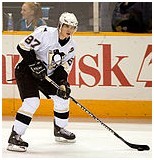
After a mediocre start to the 2007–08 season, Crosby and starting goaltender Fleury were both injured long-term due to high right ankle sprains. In their absence, the Penguins flourished due to the play and leadership of center Evgeni Malkin and backup goaltender Ty Conklin. The Penguins markedly improved in January, and fell no lower than the third seed in the East from that point onward. On February 26, the Penguins would acquire Atlanta star right winger Marian Hossa and forward Pascal Dupuis at the NHL trade deadline, relinquishing Colby Armstrong, Erik Christensen, Angelo Esposito, and a first round pick in the 2008 NHL Entry Draft. The Penguins also acquired defensemen Hal Gill from theToronto Maple Leafs for a second round pick in the 2008 NHL Entry Draft and a fifth round pick in the 2009 NHL Entry Draft.
On April 2, 2008, the Penguins clinched the Atlantic Division title—their first division title in 10 years—with a 4–2 win against rivals the Philadelphia Flyers. However, they closed the season with a loss to the Flyers on the next night, relegating them to the second seed in the East behind the Montreal Canadiens. The Pens had spent most of the second half going back and forth with the Habs for first place in the East. EvgeniMalkin finished the season with 106 points for second place in the league just behind Washington'sAlexander Ovechkin and become a finalist for the Hart Memorial Trophy. This was the first time that neither the New Jersey Devils nor the Philadelphia Flyers won the Atlantic Division since the New York Rangers won the inaugural one, when they won the 1994 Stanley Cup.
The team launched into their first extended playoff run in many years, beating Ottawa 4–0, defeating the New York Rangers 4–1 and then defeating the Philadelphia Flyers 4–1 to clinch the Prince of Wales Trophy. Pittsburgh went on to lose the 2008 Stanley Cup Finals to the Detroit Red Wings in six games, finishing the playoffs with a 14–6 record. Sidney Crosby finished the playoffs with 27 points (6g, 21a in 20 games), tying Conn Smythe-winner Henrik Zetterberg (13g, 14a in 22 games) for the playoff scoring lead.
2008–09 season: Third Stanley Cup
Main article: 2008–09 Pittsburgh Penguins season
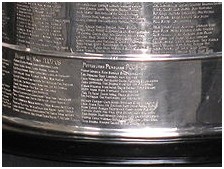
In the 2008–09 season, Malkin won the Art Ross by narrowly defeating rival Ovechkin in the points race and was a candidate for the Hart Memorial Trophy for MVP. Crosby finished third in league scoring with 33 goals and 70 assists for 103 points despite missing 5 games. The Penguins' record dipped mid-season but lifted after head coach Michel Therrien was replaced by Dan Bylsma and defenseman Sergei Gonchar returned from injury. The effect was almost instantaneous and the Penguins recovered enough to secure home ice advantage in their first round matchup against the Philadelphia Flyers, whom the Penguins defeated in six games. The next series, against Washington, took all seven games for the Penguins to win, sending them to the Eastern Conference Finals where they beat the Carolina Hurricanes in four games. After defeating the Hurricanes, the Penguins earned their second consecutive trip to the Stanley Cup Finals against the Detroit Red Wings, to whom they had lost the previous. After losing Games 1 and 2 in Detroit, just like the previous years, the Penguins won Games 3 and 4 in Pittsburgh. Each team won on home ice in Games 5 and 6. In Game 7 in Detroit, Max Talbot scored two goals and the Penguins won 2–1 to earn their third Stanley Cup.[20] Malkin's dominant playoff performance was rewarded by the Conn Smythe trophy.
2009–present
On Friday October 2, the Penguins opened the 2009–10 season against the New York Rangers. It was the last home opener at the Mellon Arena and it was also the night the team raised the championship banner. The Penguins started the season by winning a franchise record seven road games to start a season.[21] For the second straight year the Penguins finished the season in second place behind New Jersey. Crosby scored 109 points (51 goals, 58 assists) in 81 games finishing second in scoring to HenrikSedin 112 points (29 goals, 83 assists) in 82 games. Crosbys 51 goals earning him the Maurice Rocket Richard Trophy awarded to the leading goal scorer of the NHL. The Penguins seeded 4th in the conference started their title defense against the Ottawa Senators. The Penguins lost Game 1 5–4 but went on to win the next 3. With the Penguins up 3–1 in their series, they looked to close out the series in 5 games. Game 5 went to 3 overtimes before Matt Carkner won the game. The Penguins won Game 6 in overtime despite being down 3–0 early in the game. In the next round the Penguins faced the Montreal Canadiens. The teams would swap wins with the Penguins taking a 3–2 series lead. The Penguins lost Game 6 4–3. In Game 7, the Penguins never got off on the right foot and lost 5–2 ending their season and their tenure at the Mellon Arena. Coincidentally, the Canadiens opened and closed the Mellon Arena with wins.
In 2010–11, the Penguins played their first game in the Consol Energy Center, a loss to their rivals the Philadelphia Flyers. The start of the season was reasonably successful, and the Penguins played in the NHL Winter Classic versus theWashington Capitals. However, the season was marred by a season ending concussion to Sidney Crosby and a season ending knee injury to Evgeni Malkin. After some difficulties, the Penguins managed to cope, particularly through the enhanced play of Jordan Staal and a 10–3 record in shootouts, and ended up second in the Atlantic Division to the Philadelphia Flyers. Despite this success, the Penguins made an early exit in the playoffs, losing the series after taking a 3 games to 1 lead over the Tampa Bay Lightning, with the goaltending of Marc-Andre Fleury called into question.
With Sidney Crosby still sidelined with post concussion syndrome, at the start of the 2011–12 season, EvgeniMalkin led the Penguins' top line and dominated league scoring. He finished with 50 goals and 109 points as the Penguins earned 51 wins on the season. The Penguins' offense was reinforced by the breakout performances of James Neal, who scored 40 goals, and Jordan Staal, who set a career high in points while missing significant time with injuries. With Malkin's Art Ross winning performance and Crosby's late season return from injury, the Penguins headed into the playoffs with high hopes of making a significant Cup run. However, the highly favored Penguins were defeated in six games by their cross-state rivals, the Philadelphia Flyers.[22] Malkin was later awarded the Hart Trophy and Lester B. Pearson Award.
Following the Penguins' disappointing playoff exit, general manager Ray Shero made sweeping changes to the team at the 2012 NHL Entry Draft. After Jordan Staal rejected a 10-year offer to stay with the Penguins, he was traded to theCarolina Hurricanes for the 8th overall draft pick (Derrick Pouliot), Brandon Sutter, and Brian Dumoulin. The Penguins then traded Zbynek Michalek to the Phoenix Coyotes for a third round draft pick, Marc Cheverie, and minor prospect Harrison Ruopp. The Penguins also signed veteran goaltender Tomas Vokoun to a two-year contract after acquiring his negotiating rights for a 7th round draft pick.[23][24][25] On March 28, 2013, Pittsburgh acquired longtime captain and Calgary Flames player Jarome Iginla in exchange for prospects Kenneth Agostino and Ben Hanowski and a first-round pick in 2013. [26] Days prior to the Iginla trade, the Penguins acquired Dallas Stars captain Brenden Morrow along with a third-round pick in 2013 and hard hitting defensemen Douglas Murray from the San Jose Sharks. In return for Morrow, Dallas received touted prospect Joe Morrow and a fifth-round pick in 2013 and San Jose acquired second-round picks in 2013 and 2014. Finally, on April 3rd, JussiJokinen was added from the Carolina Hurricanes.
Logos and uniforms
With the exception of the 1992–2001 period, the Penguins have used a variation of the "skating penguin" logo since the team's inception. For their inaugural season, the logo featured a hefty-looking skating penguin wearing a scarf, on a yellow triangle inside a circle reading "Pittsburgh Penguins". The yellow triangle is a reference to the Golden Triangle in the city of Pittsburgh. General manager Jack Riley felt the team's name and logo were ridiculous, and refused to have either appear on the team's uniforms, which featured only the word "PITTSBURGH" diagonally. A refined version of the logo appeared on a redesigned uniform in the second season, which removed the scarf and gave the penguin a sleeker, "meaner" look. The circle encompassing the logo was removed mid-season in 1971–72.
The team's colors were originally powder blue, navy blue, and white. The powder blue was changed to royal blue in 1973, but returned in 1977 when navy became the predominant uniform color. The team adopted the current black and gold color scheme in January 1980 (the announcement was made at halftime of Super Bowl XIV) to unify the colors of the city's professional sports teams, although like the Pirates and Steelers, the shade of gold more closely resembled yellow. The change was not without controversy, as the Boston Bruins protested by claiming to own the rights to the black and gold colors. However the Penguins cited the colors worn by the now-defunct NHL team Pittsburgh Pirates in the 1920s, thus were able to secure permission to use the black and gold colors.
This would remain unchanged until the 1992–93 season, when the team unveiled new uniforms and a new logo. The logo featured a modern-looking "flying penguin". Although the logo survived in various forms for 15 years, it received mixed responses from fans and was never as widely accepted as the "skating penguin" logo. Longtime KDKA anchor Bill Burns even went as far as calling the penguin in the logo "a pigeon."
After Mario Lemieux (a personal fan of the "skating penguin" logo) purchased the team from bankruptcy court in 1999, he announced plans to bring back the "skating penguin" logo. This occurred for the 2000–01 season, when the team revived the logo (albeit with a "Vegas gold" triangle instead of yellow) on the chest of the team's new alternate jerseys. In 2002–2003, the logo became the primary logo, and the "flying penguin" logo (also with a "Vegas gold" triangle instead of yellow) was relegated to secondary status, and only on the shoulders of the team's jerseys, until it was quietly retired in 2007 when the team introduced their version of the Rbk Edge uniforms.
The uniforms themselves have changed several times over the years. The original jerseys from the team's first season had diagonal text reading "Pittsburgh". Currently, only images of these uniforms survive, although the jersey is available in NHL Hitz 20-03 and several EA Sports NHL series games as an alternate jersey for the team. The uniforms themselves were discovered nearly thirty years later in a garbage bag by a Civic Arena employee at the arena. Due to the years of neglect in the bag, the uniforms were damaged beyond repair. The following season, a revised version of the logo was used on a completely redesigned uniform. Player names were first added in 1970.
Until 1977, the team had some minor striping patterns on the jerseys change every few years. But in 1977, the team basically adopted their longest-lasting uniform style to date and a style they would wear for the next 16 seasons, winning the Stanley Cup twice in the process. When the colors were swapped from blue and white to black and gold in 1980, the uniform patterns themselves remained unchanged. This was likely due to the fact that the change was made in the middle of the season. From the 1981–82 season to the 1984–85 season, the team had a gold "Sunday" jersey, called as such because the team only worn them on Sundays. This was a rare example of an NHL team having a third jersey before the rule allowing such jerseys was officially implemented in 1995.
After winning their second Stanley Cup in 1992, the team completely redesigned their uniforms and introduced the "flying penguin" logo. The team's away uniforms were somewhat of a throwback to the team's first season, as they revived the diagonal "Pittsburgh" script. In 1995, the team introduced their second alternate jersey, which was a black Penguins jersey with the team's logo and had blue accents, an obvious throwback to the original team colors. This jersey would prove to be so popular that the team adopted it as their away jersey in 1997.
In 2000, the team unveiled yet another alternate jersey, the aforementioned black jersey featuring the revival of the "skating penguin" logo. This would later prove to be a test to see how the revived logo would do with fans, and the following season became the team's away uniform with a white version as the team's home jersey. This time, the gold used is known as "Vegas gold", a more metallic shade. When the Rbk Edge jerseys were unveiled for the 2007–08 seasonleaguewide, the Penguins made some major striping pattern changes and quietly removed the "flying penguin" logo from the shoulders. They also added a "Pittsburgh 250" gold circular patch to the shoulders to commemorate the 250th birthday of the city of Pittsburgh.
While the Penguins, as with the rest of the NHL, have worn their dark jerseys at home since the league made the initiative to do so starting with the 2003–04 NHL season, the team wore their white jerseys in some home games during the2007–08 NHL season and at least once during the 2008–09 NHL season, as well as wearing their powder blue, 1968–72 throwbacks against the Buffalo Sabres in the AMP Energy NHL Winter Classic. On November 5, 2008, this jersey was introduced as the current third jersey. This was worn for select home games during the 2008–09, 2009–10 and 2010–11 seasons. This throwback was supposedly to be retired with the introduction of a new dark blue third jersey that made its debut at the 2011 NHL Winter Classic at Heinz Field[27] but it has been worn at several games since the Winter Classic. The new 2011 Winter Classic jersey was first worn as the third jersey against the LA Kings on February 10, 2011. After this the Penguins quit using their 2008 Winter Classic jerseys.
For the 2011–2012 season, the 2011 Winter Classic jersey was the team's official third uniform, with the 2008 Winter Classic uniform being retired.[28] Called the "Blue Jerseys of Doom" by the Pittsburgh Tribune-Review, the alternate jerseys were worn when Sidney Crosby sustained a broken jaw injury on March 30, 2013 and also when he received a concussion in the 2011 Winter Classic. Center EvgeniMalkin was also injured, also with a concussion, during a game when the Penguins donned the alternate uniforms on February 22, 2013. The team was set to wear the blue jerseys for an April 2, 2013 game against the Buffalo Sabres, three days after Crosby sustained a broken jaw wearing one, but instead wore their black and vegas gold home jerseys.[29] On April 4, 2013, the Penguins announced that the club would not wear an alternate uniform for the 2013-14 season. The club announced that they were in the process of working up a new design for possibly the 2014-15 season, which is the 30th anniversary of majority co-owner Mario Lemieux's rookie season, however there is currently no set timetable for the new alternate uniform to debut.[30]
Hall of Famers
Players
• Andy Bathgate, RW, (1967–68, 1970–71) inducted 1978
• Leo Boivin, D, (1967–69) inducted 1986
• Paul Coffey, D, (1987–92) inducted 2004
• Ron Francis, C, (1990–98) inducted 2007
• Tim Horton, D, (1971–72) inducted 1977
• Mario Lemieux, C, (1984–97, 2000–06) inducted 1997
• Joe Mullen, RW, (1990–95, 1996–97) inducted 2000
• Larry Murphy, D, (1990–95) inducted 2004
• Luc Robitaille, LW, (1995) inducted 2009
• Bryan Trottier, C, (1990–94) inducted 1997
Builders
• Scotty Bowman, director of player development & head coach, (1990–93) inducted 1991
• Bob Johnson, head coach, (1990–91) inducted 1992
• Craig Patrick, GM & head coach, (1989–06) inducted 2001
• Herb Brooks, head coach, (1999–00), head scout (1994–99, 2000–03) inducted 2006
Other
• Media – Mike Lange, broadcaster (1974–75, 1976–present) inducted 2001 – Foster Hewitt Memorial Award
• Media – Dave Molinari, Newspaper Writer Pittsburgh Post-Gazette inducted 2009 – Elmer Ferguson Memorial Award
Penguins Hall of Fame
• Bob Johnson, head coach (1990–91) inducted 1992
• Jean Pronovost, RW (1968–78) inducted 1992
• Rick Kehoe, RW (1974–85) inducted 1992
• Syl Apps, Jr., C (1970–78) inducted 1994
• Edward J. DeBartolo Sr., owner (1977–91) inducted 1996
• Dave Burrows, D (1971–78, 1980–82) inducted 1996
• Elaine Heufelder, front office (1967–03) inducted 1996
• Mario Lemieux, C (1984–97, 2000–06), owner (1999–present) inducted 1999
• Jack Riley, GM (1967–70, 1972–74) inducted 1999
• Joe Mullen, RW (1990–95, 1996–97) inducted 2000
• Craig Patrick, GM (1989–06) inducted 2001
• Mike Lange, broadcaster (1974–75, 1976–present) inducted 2001
• Anthony "A.T." Caggiano, locker room (1967–00) inducted 2001
• Les Binkley, G (1967–72) inducted 2003
• Ulf Samuelsson, D (1991–95) inducted 2003
• Vince Lascheid, organist (1970–03) inducted 2003
• Paul Coffey, D (1987–92) inducted 2007
• Frank Sciulli, locker room (1967–07) inducted 2007
Team captains
• Ab McDonald, 1967–68
• Earl Ingarfield, 1968-69
• No Captain 1969-73
• Ron Schock, 1973–77
• Jean Pronovost, 1977–78
• Orest Kindrachuk, 1978–81
• Randy Carlyle, 1981–84
• Mike Bullard, 1984–86
• Terry Ruskowski, 1986–87
• Dan Frawley, 1987
• Mario Lemieux, 1987–94
• Ron Francis, 1995[35]
• Mario Lemieux, 1995–97
• Ron Francis, 1997–98
• Jaromir Jagr, 1998–01
• Mario Lemieux, 2001–06
• Sidney Crosby, 2007–present
Penguins' Ring of Honor
A mural honoring members of the franchise's "Millennium Team", it was first displayed September 26, 2003.[36] This was a permanent display at Mellon Arena until its demolition, designed to honor past greats without having to retire their numbers. Current members are:
• Tom Barrasso (G)
• Les Binkley (G)
• Herb Brooks (Coach)
• Dave Burrows (D)
• Paul Coffey (D)
• Ron Francis (F)
• Jaromir Jagr (F)
• Bob Johnson (Coach)
• Rick Kehoe (F)
• Mario Lemieux (F)
• Larry Murphy (D)
• Craig Patrick (GM-coach)
• Jean Pronovost (F)
• Ulf Samuelsson (D)
• Kevin Stevens (F)
• Mark Recchi (F)
NHL awards and trophies
Stanley Cup[39]
• 1990–91, 1991–92, 2008–09
Presidents' Trophy[40]
• 1992–93
Prince of Wales Trophy[41]
• 1990–91, 1991–92, 2007–08, 2008–09
Art Ross Trophy[42]
• Mario Lemieux: 1987–88, 1988–89, 1991–92, 1992–93, 1995–96, 1996–97
• Jaromir Jagr: 1994–95, 1997–98, 1998–99, 1999–00, 2000–01
• Sidney Crosby: 2006–07
• Evgeni Malkin: 2008–09, 2011–12
Bill Masterton Memorial Trophy[43]
• Lowell MacDonald: 1972–73
• Mario Lemieux: 1992–93
Calder Memorial Trophy[44]
• Mario Lemieux: 1984–85
• Evgeni Malkin: 2006–07
Conn Smythe Trophy[45]
• Mario Lemieux: 1990–91, 1991–92
• Evgeni Malkin: 2008–09
Frank J. Selke Trophy[46]
• Ron Francis: 1994–95
Hart Memorial Trophy[47]
• Mario Lemieux: 1987–88, 1992–93, 1995–96
• Jaromir Jagr: 1998–99
• Sidney Crosby: 2006–07
• Evgeni Malkin: 2011–12
James Norris Memorial Trophy[48]
• Randy Carlyle: 1980–81
Lady Byng Memorial Trophy[49]
• Rick Kehoe: 1980–81
• Ron Francis: 1994–95, 1997–98
Lester B. Pearson/Ted Lindsay Award[50]
• Mario Lemieux: 1985–86, 1987–88, 1992–93, 1995–96
• Jaromir Jagr: 1998–99, 1999–00
• Sidney Crosby: 2006–07
• Evgeni Malkin: 2011–12
Lester Patrick Trophy[51]
• Joe Mullen: 1994–95
• Mario Lemieux: 1999–00
• Craig Patrick: 1999–00
• Herb Brooks: 2001–02
Franchise individual records
Season
• Most goals in a season: Mario Lemieux, 85 (1988–89)
• Most assists in a season: Mario Lemieux, 114 (1988–89)
• Most points in a season: Mario Lemieux, 199 (1988–89)
• Most penalty minutes in a season: Paul Baxter, 409 (1981–82)
• Most points in a season, defenseman: Paul Coffey, 113 (1988–89)
• Most points in a season, rookie: Sidney Crosby, 102 (2005–06)
• Most wins in a season: Tom Barrasso, 43 (1992–93)
Playoffs
• Most Goals in a playoff season: Kevin Stevens, 17 (1990–91)
• Most Assists in a playoff Season: Mario Lemieux, 28 (1990–91)
• Most Points in a playoff Season: Mario Lemieux, 44 (1990–91)
• Most Points in a playoff Season, defenseman: Larry Murphy, 23 (1990–91)
• Most wins in a playoff season: Tom Barrasso, 16 (1991–92) and Marc-Andre Fleury, 16 (2008–09)
• Lowest goals against average in a playoff season: Ron Tugnutt, 1.77 (1999–00)
• Highest save percentage in a playoff season: Ron Tugnutt, .945% (1999–00)
• Most playoff shutouts: Marc-Andre Fleury, 6 Tom Barrasso, 6
• Most shutouts in a playoff season: Marc-Andre Fleury, 3 (2007–08)
• Most consecutive games in a single playoff with multiple points: Evgeni Malkin, 6 (2009)


